-
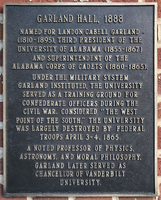 Garland Hall, 1888
Garland Hall, 1888 Named for Landon Cabell Garland (1810-1895), third President of the University of Alabama (1855-1867) and Superintendent of the Alabama Corps of Cadets (1860-1865).
Under the military system Garland instituted, the University served as a training ground for Confederate officers during the Civil War. Considered "The West Point of the South," the University was largely destroyed by federal troops April 3-4, 1865.
A noted Professor of Physics, Astronomy, and Moral Philosophy, Garland later served as Chancellor of Vanderbilt University.
-
 Gallalee Hall, 1949
Gallalee Hall, 1949 Named for John M. Gallalee (1883-1961), President of the University of Alabama (1947-1953)
-
 Foster Auditorium, 1939
Foster Auditorium, 1939 Named for Richard Clarke Foster (1895-1941), who, as President of The University of Alabama (1937-1941), raised academic standards and encouraged faculty and graduate research.
-
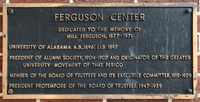 Ferguson Center [removed]
Ferguson Center [removed] Dedicated to the memory of Hill Ferguson, 1877-1971
University of Alabama A.B., 1896; LLB 1897
President of Alumni Society, 1904-1907 and originator of the Greater University Movement of that period
Member of the Board of Trustees and its Executive Committee, 1919-1959
President Protempore of the Board of Trustees, 1947-1959
-
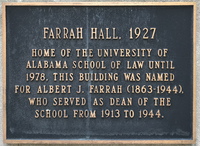 Farrah Hall, 1927
Farrah Hall, 1927 Home of the University of Alabama School of Law until 1978, this building was named for Albert J. Farrah (1863-1944), who served as Dean of the School from 1913-1944.
-
 Doster Hall, 1929
Doster Hall, 1929 Named for James J. Doster (1873-1942), Dean, College of Education (1911-1942).
Originally designed to house Home Economics, Art, and Music, this building was part of the "Women's Campus" developed on the University's southwest side during the early decades of the twentieth century.
-
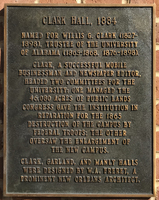 Clark Hall, 1884
Clark Hall, 1884 Named for Willis G. Clark (1827-1898), Trustee of the University of Alabama (1865-1868, 1876-1898).
Clark, a successful Mobile businessman and newspaper editor, headed two committees for the University: one managed the 46,080 acres of public lands Congress gave the institution in reparation for the 1865 destruction of the campus by federal troops; the other oversaw the enlargement of the new campus.
Clark, Garland, and Manly Halls were designed by W. A. Freret, a prominent New Orleans architect.
-
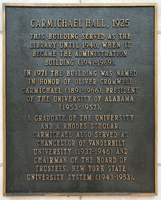 Carmichael Hall, 1925
Carmichael Hall, 1925 This building served as the library until 1940, when it became the administration building (1941-1969).
In 1971 the building was named in honor of Oliver Cromwell Carmichael (1891-1966), President of the University of Alabama (1953-1957).
A graduate of the University and a Rhodes Scholar, Carmichael also served as Chancellor of Vanderbilt University (1937-1946) and Chairman of the Board of Trustees, New York State University System (1943-1953).
-
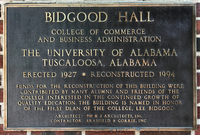 Bidgood Hall
Bidgood Hall College of Commerce
and Business Administration
The University of Alabama
Tuscaloosa, Alabama
Erected 1927 * Reconstructed 1994
Funds for the reconstruction of this building were contributed by many alumni and friends of the college interested in the continued growrth of quality education. The building is named in honor of the first Dean of the college, Lee Bidgood.
Architect: PH & J Architects, Inc.
Contractor: Brasfield & Gorrie, Inc.
-
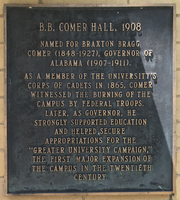 B.B. Comer Hall, 1908
B.B. Comer Hall, 1908 Named for Braxton Bragg Comer (1848-1927), Governor of Alabama (1907-1911).
As a member of the University's Corp of Cadets in 1865, Comer witnessed the burning of the campus by Federal troops. Later, as Governor, he strongly supported education and helped secure appropriations for the "Greater University Campaign," the first major expansion of the campus in the twentieth century.
-
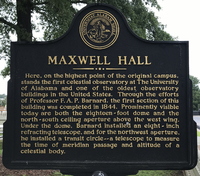 Maxwell Hall
Maxwell Hall [front]
Here, on the highest point of the original campus, stands the first celestial observatory at The University of Alabama and one of the oldest observatory buildings in the United States. Through the efforts of Professor F. A. P. Barnard, the first section of this building was completed in 1844. Prominently visible today are both the eighteen-foot dome and the north-south ceiling aperture above the west wing. Under the dome, Barnard installed an eight-inch refracting telescope, and for the northwest aperture, he installed a transit circle--a telescope to measure the time of meridian passage and altitude of a celestial body.
[reverse]
In 1858, a large classroom was added as an east wing, and today it is the oldest classroom on campus. Although ransacked by Union troops on April 4, 1865, the Observatory was one of only four structures to survive the destruction of the campus. Early in the twentieth century, the building was used for student housing. Rep. Carl Elliot lived here as an undergraduate. Later, offices for various University agencies were located here, and in 1986 the structure was named in honor of Fred R. Maxwell, Jr. for his long and dedicated service to the University. In 1993, the building was refurbished for the use of New College's External Degree and Computer-Based Honors Programs.
-
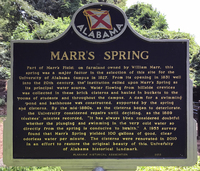 Marr's Spring
Marr's Spring Part of Marr’s Field, on farmland owned by William Marr, this spring was a major factor in the selection of this site for the University of Alabama campus in 1827. From its opening in 1831 well into the 20th century, the institution relied upon Marr’s Spring as its principal water source. Water flowing from hillside crevices was collected in these brick cisterns and hauled in buckets to the rooms of students and throughout the campus. A dam for a swimming pond and bathhouse was constructed, supported by the spring and cisterns. By the mid-1880s, as the cisterns began to deteriorate, the University considered repairs until deciding, as the 1889 trustees’ minutes recorded, “it has always been considered doubtful whether the plunging and swimming in the very cold water so directly from the spring is conducive to health.” A 1955 survey found that Marr’s Spring yielded 100 gallons of good, clear odorless water per minute. The cisterns were renovated in 2010 in an effort to restore the original beauty of this University of Alabama historical landmark.
-
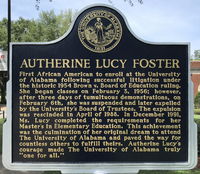 Autherine Lucy Foster
Autherine Lucy Foster First African American to enroll at the University of Alabama following successful litigation under the historic 1954 Brown v. Board of Education ruling. She began classes on February 3, 1956; however, after three days of tumultuous demonstrations, on February 6, she was suspended and later expelled by the University's Board of Trustees. The expulsion was rescinded in April of 1988. In December 1991, Ms. Lucy completed the requirements for her Master's in Elementary Education. This achievement was the culmination of her original dream to attend The University of Alabama and paved the way for countless others to fulfill theirs. Autherine Lucy's courage made The University of Alabama truly "one for all."
-
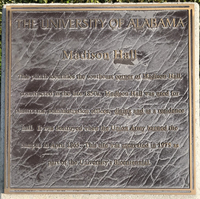 Madison Hall
Madison Hall The University of Alabama
Madison Hall
This plinth identified the southeast corner of Madison Hall, constructed in the late 1850s. Madison Hall was used for classrooms, administration offices, dining and as a residence hall. It was destroyed when the Union Army burned the campus in April 1865. This site was excavated in 1975 as part of the University's Bicentennial.
-
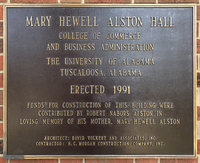 Mary Hewell Alston Hall
Mary Hewell Alston Hall College of Commerce and Business Administration
The University of Alabama
Tuscaloosa, Alabama
Erected 1991
Funds for construction of this building were contributed by Robert Nabors Alston in loving memory of his mother, Mary Hewell Alston
Architect: Davis Volkert and Associates, Inc.
Contractor: N. C. Morgan Construction Company, Inc.
-
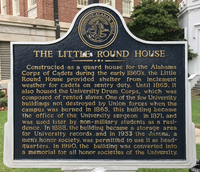 The Little Round House
The Little Round House The Little Round House
Constructed as a guard house for the Alabama Corps of Cadets during the early 1860's, the Little Round House provided shelter from inclement weather for cadets on sentry duty. Until 1865, it also housed the University Drum Corps, which was composed of rented slaves. One of the few University buildings not destroyed by Union forces when the campus was burned in 1865, this building became the office of the University surgeon in 1871, and was used later by non-military students as a residence. In 1888, the building became a storage area for University records and in 1933 the Jasons, a men's honor society, was permitted to use it as headquarters. In 1990, the building was converted into a memorial for all honor societies of the University.
-
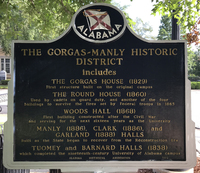 Gorgas-Manly Historical District
Gorgas-Manly Historical District [front]
Gorgas-Manly Historical District
includes
The Gorgas House (1829)
First structure built on the original campus
The Round House (1860)
Used by cadets on guard duty, and another of the four buildings to survive the fires set by Federal troops in 1865
Woods Hall (1868)
First building constructed after the Civil War and serving for the next sixteen years as the University
Manly (1886)*, Clark (1886), and Garland (1888) Halls
Built as the state began to recover from the Reconstruction Era
[*On November 13, 2020, the University of Alabama Board of Trustees voted unanimously to rename this building to Presidents Hall, to remove its association with Basil Manly, Sr., a slave-owning Baptist minister and president of the University of Alabama (1837-1855) who defended slavery and promoted a religious justification for white supremacy.]
Toumey and Barnard Halls (1838)*
which completed the nineteenth-century University of Alabama campus
[*these buildings were completed in 1889]
[reverse]
Twelve Acres of the campus of the University of Alabama
including eight buildings designated in
The National Register Of Historic Places
as
The Gorgas-Manly Historic District
-
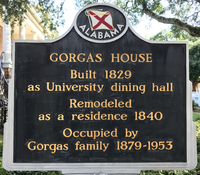 Gorgas House
Gorgas House [front]
Built 1829 as University dining hall
Remodeled as a residence in 1840
Occupied by Gorgas family 1879-1953
[reverse]
Preserved as memorial to:
General Josiah Gorgas (1818-1883)
Chief of Ordnance Confederacy 1861-1865
President of University 1878-1879
Mrs. Amelia Gayle Gorgas (1826-1913)
University Librarian 1879-1906
General William Crawford Gorgas (1854-1920)
Surgeon General of U.S. Army
Sanitary Engineer whose work in eliminating yellow fever assured Construction of Panama Canal
 Garland Hall, 1888 Named for Landon Cabell Garland (1810-1895), third President of the University of Alabama (1855-1867) and Superintendent of the Alabama Corps of Cadets (1860-1865). Under the military system Garland instituted, the University served as a training ground for Confederate officers during the Civil War. Considered "The West Point of the South," the University was largely destroyed by federal troops April 3-4, 1865. A noted Professor of Physics, Astronomy, and Moral Philosophy, Garland later served as Chancellor of Vanderbilt University.
Garland Hall, 1888 Named for Landon Cabell Garland (1810-1895), third President of the University of Alabama (1855-1867) and Superintendent of the Alabama Corps of Cadets (1860-1865). Under the military system Garland instituted, the University served as a training ground for Confederate officers during the Civil War. Considered "The West Point of the South," the University was largely destroyed by federal troops April 3-4, 1865. A noted Professor of Physics, Astronomy, and Moral Philosophy, Garland later served as Chancellor of Vanderbilt University. Gallalee Hall, 1949 Named for John M. Gallalee (1883-1961), President of the University of Alabama (1947-1953)
Gallalee Hall, 1949 Named for John M. Gallalee (1883-1961), President of the University of Alabama (1947-1953) Foster Auditorium, 1939 Named for Richard Clarke Foster (1895-1941), who, as President of The University of Alabama (1937-1941), raised academic standards and encouraged faculty and graduate research.
Foster Auditorium, 1939 Named for Richard Clarke Foster (1895-1941), who, as President of The University of Alabama (1937-1941), raised academic standards and encouraged faculty and graduate research. Ferguson Center [removed] Dedicated to the memory of Hill Ferguson, 1877-1971 University of Alabama A.B., 1896; LLB 1897 President of Alumni Society, 1904-1907 and originator of the Greater University Movement of that period Member of the Board of Trustees and its Executive Committee, 1919-1959 President Protempore of the Board of Trustees, 1947-1959
Ferguson Center [removed] Dedicated to the memory of Hill Ferguson, 1877-1971 University of Alabama A.B., 1896; LLB 1897 President of Alumni Society, 1904-1907 and originator of the Greater University Movement of that period Member of the Board of Trustees and its Executive Committee, 1919-1959 President Protempore of the Board of Trustees, 1947-1959 Farrah Hall, 1927 Home of the University of Alabama School of Law until 1978, this building was named for Albert J. Farrah (1863-1944), who served as Dean of the School from 1913-1944.
Farrah Hall, 1927 Home of the University of Alabama School of Law until 1978, this building was named for Albert J. Farrah (1863-1944), who served as Dean of the School from 1913-1944. Doster Hall, 1929 Named for James J. Doster (1873-1942), Dean, College of Education (1911-1942). Originally designed to house Home Economics, Art, and Music, this building was part of the "Women's Campus" developed on the University's southwest side during the early decades of the twentieth century.
Doster Hall, 1929 Named for James J. Doster (1873-1942), Dean, College of Education (1911-1942). Originally designed to house Home Economics, Art, and Music, this building was part of the "Women's Campus" developed on the University's southwest side during the early decades of the twentieth century. Clark Hall, 1884 Named for Willis G. Clark (1827-1898), Trustee of the University of Alabama (1865-1868, 1876-1898). Clark, a successful Mobile businessman and newspaper editor, headed two committees for the University: one managed the 46,080 acres of public lands Congress gave the institution in reparation for the 1865 destruction of the campus by federal troops; the other oversaw the enlargement of the new campus. Clark, Garland, and Manly Halls were designed by W. A. Freret, a prominent New Orleans architect.
Clark Hall, 1884 Named for Willis G. Clark (1827-1898), Trustee of the University of Alabama (1865-1868, 1876-1898). Clark, a successful Mobile businessman and newspaper editor, headed two committees for the University: one managed the 46,080 acres of public lands Congress gave the institution in reparation for the 1865 destruction of the campus by federal troops; the other oversaw the enlargement of the new campus. Clark, Garland, and Manly Halls were designed by W. A. Freret, a prominent New Orleans architect. Carmichael Hall, 1925 This building served as the library until 1940, when it became the administration building (1941-1969). In 1971 the building was named in honor of Oliver Cromwell Carmichael (1891-1966), President of the University of Alabama (1953-1957). A graduate of the University and a Rhodes Scholar, Carmichael also served as Chancellor of Vanderbilt University (1937-1946) and Chairman of the Board of Trustees, New York State University System (1943-1953).
Carmichael Hall, 1925 This building served as the library until 1940, when it became the administration building (1941-1969). In 1971 the building was named in honor of Oliver Cromwell Carmichael (1891-1966), President of the University of Alabama (1953-1957). A graduate of the University and a Rhodes Scholar, Carmichael also served as Chancellor of Vanderbilt University (1937-1946) and Chairman of the Board of Trustees, New York State University System (1943-1953). Bidgood Hall College of Commerce and Business Administration The University of Alabama Tuscaloosa, Alabama Erected 1927 * Reconstructed 1994 Funds for the reconstruction of this building were contributed by many alumni and friends of the college interested in the continued growrth of quality education. The building is named in honor of the first Dean of the college, Lee Bidgood. Architect: PH & J Architects, Inc. Contractor: Brasfield & Gorrie, Inc.
Bidgood Hall College of Commerce and Business Administration The University of Alabama Tuscaloosa, Alabama Erected 1927 * Reconstructed 1994 Funds for the reconstruction of this building were contributed by many alumni and friends of the college interested in the continued growrth of quality education. The building is named in honor of the first Dean of the college, Lee Bidgood. Architect: PH & J Architects, Inc. Contractor: Brasfield & Gorrie, Inc. B.B. Comer Hall, 1908 Named for Braxton Bragg Comer (1848-1927), Governor of Alabama (1907-1911). As a member of the University's Corp of Cadets in 1865, Comer witnessed the burning of the campus by Federal troops. Later, as Governor, he strongly supported education and helped secure appropriations for the "Greater University Campaign," the first major expansion of the campus in the twentieth century.
B.B. Comer Hall, 1908 Named for Braxton Bragg Comer (1848-1927), Governor of Alabama (1907-1911). As a member of the University's Corp of Cadets in 1865, Comer witnessed the burning of the campus by Federal troops. Later, as Governor, he strongly supported education and helped secure appropriations for the "Greater University Campaign," the first major expansion of the campus in the twentieth century. Maxwell Hall [front] Here, on the highest point of the original campus, stands the first celestial observatory at The University of Alabama and one of the oldest observatory buildings in the United States. Through the efforts of Professor F. A. P. Barnard, the first section of this building was completed in 1844. Prominently visible today are both the eighteen-foot dome and the north-south ceiling aperture above the west wing. Under the dome, Barnard installed an eight-inch refracting telescope, and for the northwest aperture, he installed a transit circle--a telescope to measure the time of meridian passage and altitude of a celestial body. [reverse] In 1858, a large classroom was added as an east wing, and today it is the oldest classroom on campus. Although ransacked by Union troops on April 4, 1865, the Observatory was one of only four structures to survive the destruction of the campus. Early in the twentieth century, the building was used for student housing. Rep. Carl Elliot lived here as an undergraduate. Later, offices for various University agencies were located here, and in 1986 the structure was named in honor of Fred R. Maxwell, Jr. for his long and dedicated service to the University. In 1993, the building was refurbished for the use of New College's External Degree and Computer-Based Honors Programs.
Maxwell Hall [front] Here, on the highest point of the original campus, stands the first celestial observatory at The University of Alabama and one of the oldest observatory buildings in the United States. Through the efforts of Professor F. A. P. Barnard, the first section of this building was completed in 1844. Prominently visible today are both the eighteen-foot dome and the north-south ceiling aperture above the west wing. Under the dome, Barnard installed an eight-inch refracting telescope, and for the northwest aperture, he installed a transit circle--a telescope to measure the time of meridian passage and altitude of a celestial body. [reverse] In 1858, a large classroom was added as an east wing, and today it is the oldest classroom on campus. Although ransacked by Union troops on April 4, 1865, the Observatory was one of only four structures to survive the destruction of the campus. Early in the twentieth century, the building was used for student housing. Rep. Carl Elliot lived here as an undergraduate. Later, offices for various University agencies were located here, and in 1986 the structure was named in honor of Fred R. Maxwell, Jr. for his long and dedicated service to the University. In 1993, the building was refurbished for the use of New College's External Degree and Computer-Based Honors Programs. Marr's Spring Part of Marr’s Field, on farmland owned by William Marr, this spring was a major factor in the selection of this site for the University of Alabama campus in 1827. From its opening in 1831 well into the 20th century, the institution relied upon Marr’s Spring as its principal water source. Water flowing from hillside crevices was collected in these brick cisterns and hauled in buckets to the rooms of students and throughout the campus. A dam for a swimming pond and bathhouse was constructed, supported by the spring and cisterns. By the mid-1880s, as the cisterns began to deteriorate, the University considered repairs until deciding, as the 1889 trustees’ minutes recorded, “it has always been considered doubtful whether the plunging and swimming in the very cold water so directly from the spring is conducive to health.” A 1955 survey found that Marr’s Spring yielded 100 gallons of good, clear odorless water per minute. The cisterns were renovated in 2010 in an effort to restore the original beauty of this University of Alabama historical landmark.
Marr's Spring Part of Marr’s Field, on farmland owned by William Marr, this spring was a major factor in the selection of this site for the University of Alabama campus in 1827. From its opening in 1831 well into the 20th century, the institution relied upon Marr’s Spring as its principal water source. Water flowing from hillside crevices was collected in these brick cisterns and hauled in buckets to the rooms of students and throughout the campus. A dam for a swimming pond and bathhouse was constructed, supported by the spring and cisterns. By the mid-1880s, as the cisterns began to deteriorate, the University considered repairs until deciding, as the 1889 trustees’ minutes recorded, “it has always been considered doubtful whether the plunging and swimming in the very cold water so directly from the spring is conducive to health.” A 1955 survey found that Marr’s Spring yielded 100 gallons of good, clear odorless water per minute. The cisterns were renovated in 2010 in an effort to restore the original beauty of this University of Alabama historical landmark. Autherine Lucy Foster First African American to enroll at the University of Alabama following successful litigation under the historic 1954 Brown v. Board of Education ruling. She began classes on February 3, 1956; however, after three days of tumultuous demonstrations, on February 6, she was suspended and later expelled by the University's Board of Trustees. The expulsion was rescinded in April of 1988. In December 1991, Ms. Lucy completed the requirements for her Master's in Elementary Education. This achievement was the culmination of her original dream to attend The University of Alabama and paved the way for countless others to fulfill theirs. Autherine Lucy's courage made The University of Alabama truly "one for all."
Autherine Lucy Foster First African American to enroll at the University of Alabama following successful litigation under the historic 1954 Brown v. Board of Education ruling. She began classes on February 3, 1956; however, after three days of tumultuous demonstrations, on February 6, she was suspended and later expelled by the University's Board of Trustees. The expulsion was rescinded in April of 1988. In December 1991, Ms. Lucy completed the requirements for her Master's in Elementary Education. This achievement was the culmination of her original dream to attend The University of Alabama and paved the way for countless others to fulfill theirs. Autherine Lucy's courage made The University of Alabama truly "one for all." Madison Hall The University of Alabama Madison Hall This plinth identified the southeast corner of Madison Hall, constructed in the late 1850s. Madison Hall was used for classrooms, administration offices, dining and as a residence hall. It was destroyed when the Union Army burned the campus in April 1865. This site was excavated in 1975 as part of the University's Bicentennial.
Madison Hall The University of Alabama Madison Hall This plinth identified the southeast corner of Madison Hall, constructed in the late 1850s. Madison Hall was used for classrooms, administration offices, dining and as a residence hall. It was destroyed when the Union Army burned the campus in April 1865. This site was excavated in 1975 as part of the University's Bicentennial. Mary Hewell Alston Hall College of Commerce and Business Administration The University of Alabama Tuscaloosa, Alabama Erected 1991 Funds for construction of this building were contributed by Robert Nabors Alston in loving memory of his mother, Mary Hewell Alston Architect: Davis Volkert and Associates, Inc. Contractor: N. C. Morgan Construction Company, Inc.
Mary Hewell Alston Hall College of Commerce and Business Administration The University of Alabama Tuscaloosa, Alabama Erected 1991 Funds for construction of this building were contributed by Robert Nabors Alston in loving memory of his mother, Mary Hewell Alston Architect: Davis Volkert and Associates, Inc. Contractor: N. C. Morgan Construction Company, Inc. The Little Round House The Little Round House Constructed as a guard house for the Alabama Corps of Cadets during the early 1860's, the Little Round House provided shelter from inclement weather for cadets on sentry duty. Until 1865, it also housed the University Drum Corps, which was composed of rented slaves. One of the few University buildings not destroyed by Union forces when the campus was burned in 1865, this building became the office of the University surgeon in 1871, and was used later by non-military students as a residence. In 1888, the building became a storage area for University records and in 1933 the Jasons, a men's honor society, was permitted to use it as headquarters. In 1990, the building was converted into a memorial for all honor societies of the University.
The Little Round House The Little Round House Constructed as a guard house for the Alabama Corps of Cadets during the early 1860's, the Little Round House provided shelter from inclement weather for cadets on sentry duty. Until 1865, it also housed the University Drum Corps, which was composed of rented slaves. One of the few University buildings not destroyed by Union forces when the campus was burned in 1865, this building became the office of the University surgeon in 1871, and was used later by non-military students as a residence. In 1888, the building became a storage area for University records and in 1933 the Jasons, a men's honor society, was permitted to use it as headquarters. In 1990, the building was converted into a memorial for all honor societies of the University. Gorgas-Manly Historical District [front] Gorgas-Manly Historical District includes The Gorgas House (1829) First structure built on the original campus The Round House (1860) Used by cadets on guard duty, and another of the four buildings to survive the fires set by Federal troops in 1865 Woods Hall (1868) First building constructed after the Civil War and serving for the next sixteen years as the University Manly (1886)*, Clark (1886), and Garland (1888) Halls Built as the state began to recover from the Reconstruction Era [*On November 13, 2020, the University of Alabama Board of Trustees voted unanimously to rename this building to Presidents Hall, to remove its association with Basil Manly, Sr., a slave-owning Baptist minister and president of the University of Alabama (1837-1855) who defended slavery and promoted a religious justification for white supremacy.] Toumey and Barnard Halls (1838)* which completed the nineteenth-century University of Alabama campus [*these buildings were completed in 1889] [reverse] Twelve Acres of the campus of the University of Alabama including eight buildings designated in The National Register Of Historic Places as The Gorgas-Manly Historic District
Gorgas-Manly Historical District [front] Gorgas-Manly Historical District includes The Gorgas House (1829) First structure built on the original campus The Round House (1860) Used by cadets on guard duty, and another of the four buildings to survive the fires set by Federal troops in 1865 Woods Hall (1868) First building constructed after the Civil War and serving for the next sixteen years as the University Manly (1886)*, Clark (1886), and Garland (1888) Halls Built as the state began to recover from the Reconstruction Era [*On November 13, 2020, the University of Alabama Board of Trustees voted unanimously to rename this building to Presidents Hall, to remove its association with Basil Manly, Sr., a slave-owning Baptist minister and president of the University of Alabama (1837-1855) who defended slavery and promoted a religious justification for white supremacy.] Toumey and Barnard Halls (1838)* which completed the nineteenth-century University of Alabama campus [*these buildings were completed in 1889] [reverse] Twelve Acres of the campus of the University of Alabama including eight buildings designated in The National Register Of Historic Places as The Gorgas-Manly Historic District Gorgas House [front] Built 1829 as University dining hall Remodeled as a residence in 1840 Occupied by Gorgas family 1879-1953 [reverse] Preserved as memorial to: General Josiah Gorgas (1818-1883) Chief of Ordnance Confederacy 1861-1865 President of University 1878-1879 Mrs. Amelia Gayle Gorgas (1826-1913) University Librarian 1879-1906 General William Crawford Gorgas (1854-1920) Surgeon General of U.S. Army Sanitary Engineer whose work in eliminating yellow fever assured Construction of Panama Canal
Gorgas House [front] Built 1829 as University dining hall Remodeled as a residence in 1840 Occupied by Gorgas family 1879-1953 [reverse] Preserved as memorial to: General Josiah Gorgas (1818-1883) Chief of Ordnance Confederacy 1861-1865 President of University 1878-1879 Mrs. Amelia Gayle Gorgas (1826-1913) University Librarian 1879-1906 General William Crawford Gorgas (1854-1920) Surgeon General of U.S. Army Sanitary Engineer whose work in eliminating yellow fever assured Construction of Panama Canal